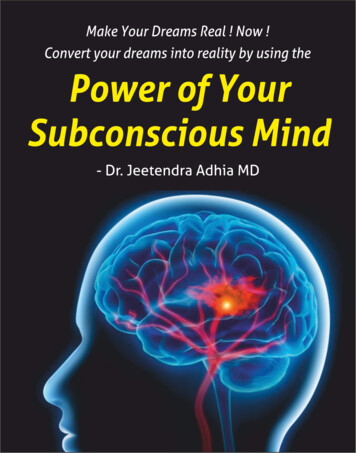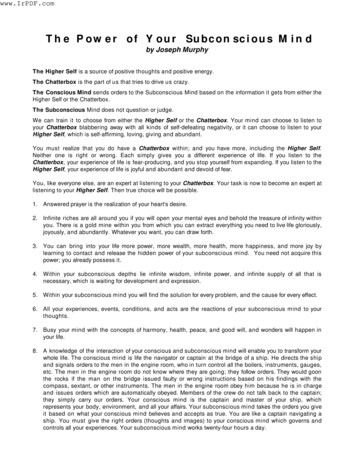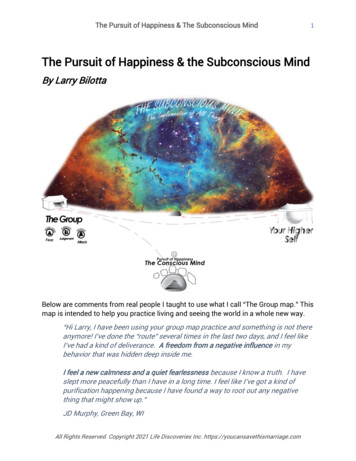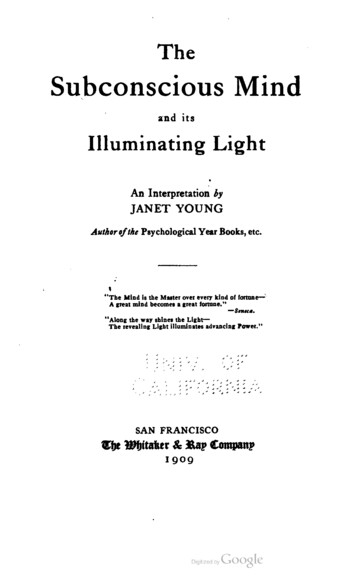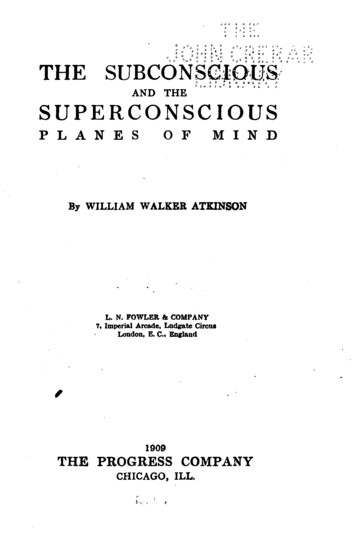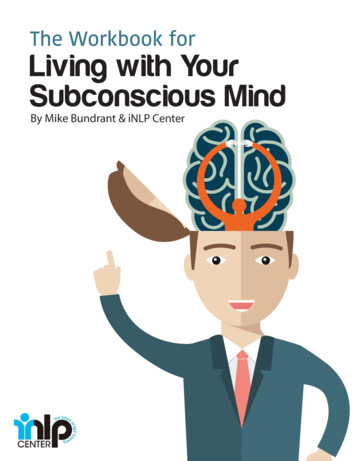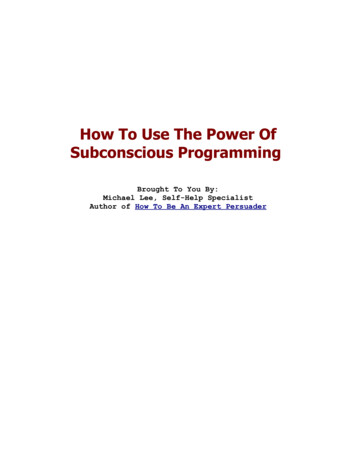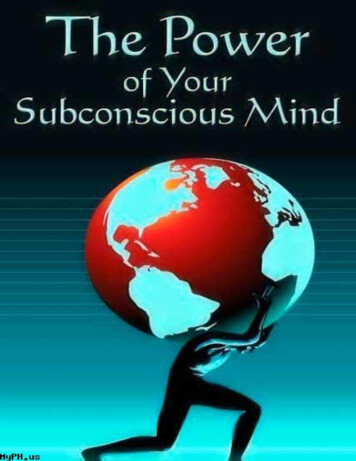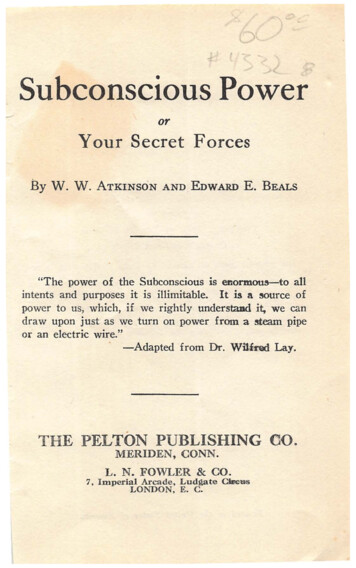
Transcription
Subconscious PowerorYour Secret ForcesBy w . w.ATKINSON AND EDWARD E. BEALS"The power of the Subconscious is enormou!t-to allintents and purposes it is illimitable. It is a urce ofpower to us, which, if we rightly understand it, we candraw upon just as we turn on power from a Meam pipeor an electric wire."- Adapted from Dr. Wilfred Lay.THE PELTON PUBLISHING CO.MERIDEN, CONN.L. N. FOWLER & CO.7, Imperial Arcade, Ludgate Cil ct1SLONDON, E. C.
SUBCONSCIOUS POWERCoPYJUGHT,1922,BY EDWARDE. BEALSCopyright in Great BritainThe properey right of Edward E. Beals in this work is ac·knowledged in the United States of America and in the countriessubscribing to and adhering ·to the Berne Convention creating anInternational Union for the protection of Literary and Artisticworks; as Revised; and the property right in this work is re·served under all Conventions and Treaties . in force.AU rights re1eruetJ, mclutJing the right of lrotulatiofo intoforeio languages, im:lutJing the Sca dinoflia .Pritd8tJ ill the U itetJ State u/ Alllllriccs
CONTENTSI.Your Secret Forces . . . .5II.Subconscious Mentation .16III.Subconscious Vital Processes . .36IV.Subconscious Habitual Action . . .56v.VI.Subconscious EmotionandMemory 70Subconscious Psycho-Analysis .87VII.Subconscious Thought . . . . . 123VIII.The Superconscious Plana . . . . 1543
SUBCONSCIOUS. POWERIYOUR SECRET FORCESIn this book you are asked to considec somewonderful phases of your Personal Powerthat Personal Power which is the expressionand manifestation through you of that greatprinciple of All-Power from which all phasesand forms of Power proceed, and in which allsuch are contained-this principle is .known inthis instruction as "POWER."In several of the other volumes of this seriesof instruction upon the subject of PersonalPower, we have asked you to consider thoseparticular phases of your Personal Powerwhich are known, respectively, as CreativePower, Desire Power, Faith Power, Will Power, etc. While in nearly all of those books oc', casional reference has been made to the activi- - ties of the Subconscious Planes of Mind andWill, their primary subject matter has · beenthat which is concerned chiefly with the respective processes of the several phases ofmental activity manifesting on the planes ofordinary consciousness.5
p5UBCONSCIOUS POWERIn the present book, on the contrary, youare asked to consider those comparatively little known a-ctivities of the mind and will whichlie outside of and beyond the field of ordinary flconsciousness, but which exert a tremendous .-!influence over the activities of that region, and which to a great extent supply that realm withthe material of ideas, mental images, andemotional states.While the mental planes lying outside ofand beyond the field of ordinary consciousnesshave been until recent years comparatively unexplored by psychologists, and in fact havebeen almost entirely ignored by western psychology until modern times, the best thoughtof the present time is in practical agreementupon the fact that on those hidden planes ofmentality are performed the major portion ofour mental work, and that in their field are itioperation some of the most important of ourmental processes.The exploration of these obscure regions ofthe mind has been one of the most . fascinating 1tasks of modern psychology; and the mines haveyielded rich material in abundance. Many mental phenomena formerly either denied as impossible by the orthodox psychologists, or else re.garded by the average person as evidence of· supernatural agencies and forces, are now .seento fit perfeotly into the natural order of things,and to operate according to natural law and or-
YOUR SECRET FORCES7der. Not only have such investigations resultedin a greater increase of the scientific knowledgeconcerning the inner workings of the mind, butthey have also served to place in the hands of themore advanced psychologists the material whichthey have turned to practical and efficient useby means of scientific methods of application.The effect of these discoveries has been thepresentation of an important truth to the thinking individual-the truth that his mental realmis a far greater and grander land that he hasheretofore considered it to be. No longer is theSelf held to be limited in its mental activities tothe narrow field of ordinary consciousness. Yourmental kingdom has suddenly expanded until itnow constitutes a great empire, with bordersflung wide and far beyond the boundaries of thelittle kingdom which you have been consideringas the entire area of the field of the forces, powers and activities of the Self.The Self has often been likened to the king ofa great mental kingdom; but, in view of the discovery of the new facts concerning the wonderfulfield of the unconscious, subconscious, and superconscious mental activities, the Self is now moreproperly to be represented as a mighty emperorof a vast empire of which only a comparativelysmall portion has as yet been explored. You arebeing called upon to appreciate more fully theancient aphorism : "You are greater than youknow." Your Self is like a new Columbus, gaz-
8SUBCONSCIOUS POWERing. at the great new world which it has discovered around itself, and of which it is theowner and the ruler.The writers on the subject of the realm of theSubconscious Mentality, being impressed by thevastness of this new empire of the Selt, haveexercised their imaginations in the direction ofsupplying familiar illustrations borrowed fromthe world of concrete material things. It isastonishing to discover how close is the analogyfurnished by certain of these illustrations andfigurative symbols. We ask you to consider thefollowing symbollic representations in order thatyour mind may more readily grasp the greattruths involved in these new discoveries concerning the realm and power of the SubconsciousMentality.Some writers have compared the subconsciousand the conscious regions of the mind to thevisible and invisible portions of the solar spectrum. Science informs us that the visible portionof the solar spectrum, with its red, orange, yellow, green, blue, indigo and violet rays, is bounded on its lower side by a region of infra-red rays,and on its upper side by a region of ultra-violetrays, these invisible fields of light extending almost indefinitely in either direction. These hidden rays are invisible to our unaided eyes, butare recorded by delicate scientific instruments.The larger part of the heat rays emanating fromthe sun is invisible to us, and forms a portion of
YOUR SECRET FORCES,,.9the infra-red field of the solar spectrum. Likewise, the major portion of the chemical changesin the vegetable world, upol\ which depend thelife and growth of the plants, results from theaction of the ultra-violet rays which are invisible .to our unaided eyes, but which our scientific instruments faithfully record. The most powerfulrays of light, those which produce the most marked effects upon living creatutes, are the invisibleultra-violet rays-the rays of "dark light" asthey have been fancifully styled.Other writers have compared the consciousand subconscious planes of meniation to a smallluminous circle, surrounded by a great ring oftwilight; and, beyond this, an indefinite darkness-the events occurring in that twilight region, and in that night region, being quite as realas those occurring within the luminous circle.Others still have likened the mind of man to theearth, with its great underlying deposits of coaland oil, in which slumber latent light, heat andother forms of potential energy, force and power,.awaiting but some appropriate stimulus to bring ·to the surface the materials from which thoseforces may be released.* * *Ignoring to a great extent the disputes and differences on the part of the psychologists concerning the most appropriate names and terms to beemployed in the consideration of the "out of consciousness" fields of mental activity and work, and
10SUBCONSCIOUS POWERbrushing aside as non-essential the distinctionsand differentiations between the various phases ·of these activities, we shall in this instruction em' brace the entire field and its activities under thegeneral term of "The Subconscious." Employing the term, "The Subconscious," to indicate theentire field of activities of the mind which areperformed below, above, or in anyway "outsideof" the field or plane of the ordinary consciousness of the individual, we soon discover that theactivities of the Subconscious extend over a verywide range of manifestation, and embrace a greatvariety of forms of expression.In the first place, the Subconscious presidesover the activities of your. physical organism; itis the animating spirit of your physical processes.It performs the manifold tasks of digestion, assimilation, nutrition, elimination, secretion, circulation, reproduction-in short, all of your vitalprocesses. Your conscious mentality is thus relieved of these great tasks.Again, the Subconscious supervises the performance of your instinctive actions. Every action that you perform automatically, instinctively,''by habit,'' "by heart,'' and without conscious employment of thought and will, is really performedby your subconscious mentality. Your consciousmentality, thus relieved of this work, is able toconcentrate upon those other tasks which it alonecan perform. When you learn to perform anaction "by heart," or "by habit," the conscious
YOUR SECRET FORCES11mentality has turned over this particular work toyour Subconscious.·Aga n, the Subconscious is largely concernedwith the activities of your emotional nature. Youremotions which rise to the plane or level of consciousness are but the surface manifestations ofthe more elemental activities performed in thedepth! of the ocean of the Subconscious. Yourelemental and instinctive emotions have theirsource· and home in the Subconscious ; they haveaccumulated there by reason of habit, heredity orracial memory. Practically all the material ofyour emotional activities is stored on the ptani;:sand levels of the Subconscious. Again, the Subconscious presides over the processes of Memory. The subconscious planes orlevels of the mind constitute the great storehouseof the recorded impressions of memory. Moreover, on those planes or levels is performed thework of indexing and cross-indexing the memoryrecords, by means of which subsequent recollection, recognition and remembrance are renderedpossible. . These regions of your subconsciousmentality contain not only the recorded impressions of your own personal exxperience, but alsothose racial memories or inherited memories whichmanifest in you as "instinct," and which play avery important part in your life.Again, the Subconscious is able to, and frequently does, perform for you important workalong the lines of actual "thinking." By means
12SUBCONSCIOUS POWERof ''mental rumination" it digests and assimilatesthe materials furnished by your conscious mentality, and then proceeds to classify these, to compare them, and to proceed to form judgments anddecisions upon them and from them-all belowthe levels of your ordinary consciousness. Careful psychologists have decided that by far thegreater part of our reasoning processes are reallyperformed on mental levels and planes outside ofthe field of the ordinary consciousness. Much ofyour creative mental work, particularly that of theconstructive imagination, is performed in this way,the result afterward being raised to the levels ofconscious thought.Finally, there. are levels and planes "above"those of the ordinary consciousness, just as thereare those "below" the latter. Just as the lowerlevels are largely concerned with working overthe stored-up materials of the past, so these higher levels are concerned with reporting that whichmay be consid red to represent the future conscious. activities of the human race. These higherregions of the Subconscious may be said to contain the seed or embryo of the higher facultiesand powers which will unfold fully in the futurestages of the mental evolution of the race; manyof these higher faculties and powers are evennow beginning to manifest in occasional flashesin the nµnds of certain individuals, and, as a consequence, such individuals are frequently regarded.,f
YOUR SECRET FORCES.,.13as "inspired" or as .possessing that indefinablequality or power known as ''genius."On these higher planes of the Subconsciousabide certain marvelous powers o:f the Self, whichpowers manifest and express themselves in thatwhich we call genius, inspiration, illuminationthe exceptional mental achievements of certainintellects which stamp them as above the average.On these high planes abide and are manifestedthose wonderful mental activities which we at. tempt to explain under the term ''Intuition."These activities, however, are not contrary to reason, though they may seem to transcend it attimes; it is better to consider them as the manifestation of a Higher Reason. The investigationand exploration of these higher realms of theSubconscious form one of the most interestingand fascinating tasks of modern psychology.Even now, the reports of the investigators andexplorers are of surpassing interest; those whichconfidently may be looked for in the future bidfaµ- to constitute a marvelous contribution to thepages of the history of modem scientific research.In this book we shall ask you to accompany usin an exploration of the various regions of theSubconscious-those wonderful realnls of yourmind-from the highest to the lowest. In thisnew land there are valuable deposits of materjaluseful to you and to all mankind. It is our purpose to point out these to you, and to instructyou in the most approved methods of mining and
14SUBCONSCIOUS POWERconverting them to practical uses. You are notspecially interested in the history of the explorations of the early travelers in this realm, nor intheir conflicting theories and their technical terms,nor in their claims of priority of discovery. Ifwe judge you rightly, you are interested chieflyin the matter of being led directly to the minescontaining these rich deposits, and in being toldjust how to conduct the mining operations andthe converting processes. In this spirit, then, ourjourney of exploration shall be conducted.* * *The Secret Forces of the Great Subconscious,like all other great natural forces, may be harnessed and pressed into service by you. Likeelectricity, they may be so managed and directedinto the proper channels that they may be set towork by and for you. You have been employing these forces, to a greater or less extent, invery many of your mental activities; but, in allprobability, you have been employing them instinctively and without a full knowledge of thelaws and principles involved in them. Whenyou understand just what these forces are, howthey work, and the methods best calculated to produce efficient results and effects, then, you mayproceed to employ them intelligently, deliberatelyand with conscious purpose and intent, end andaim.The average man employs but about 25 per cent.of his Subconscious Power. The man who under-
YOUR SECRET FORCES 1., .15stands the principles and methods to which wehave just referred will be able to employ 100 percent. of his available Subconscious Power. Thismeans that he will be able to increase fourfold hisSubconscious mental work· and activity, with correspondingly increased results and effects. Inasmuch as at least 75 per cent. of man's mentalprocesses are performed on the plane or levelof the Subconscious, it will be seen that the benefits arising from quadrupling his Subconsciousmental activities and available power ·are almostbeyond the power of adequate calculation. Thisincreased power and efficiency, moreover, are notobtained at the cost of increased effort and mentalwear and tear: on the contrary, the man effectively employing his· Subconscious relieves himself of a great portion of the mental strain incident to the employment of · the conscious mentality .
II.,;SUBCONSCIOUS MENTATIONFor many years Western Psychology held tenaciously t.o the theory that ''all there is of mind," allmental processes, all thought, all feeling, all willactivity, were contained within the narrow limitsof the ordinary consciousness. It held that theordinary consciousness was identical with "mind."We say Western Psychology, because OrientalPsychology for many centuries--for over twothousand years in fact-had recognized the ''outof consciousness" mental planes, states andprocesses. In spite of the fact that many conscious mentalstates were perceived to be but superficial manifestations of much deeper processes; in spite ofthe fact that many such mental states were seento arise from the depths of mental being lying farbelow the level of the ordinary consciousness; inspite of the fact that the emotional nature undoubtedly has its fundamental and elemental existence below the levels of the ordinary consciousness ; these old-time orthodox psychologists heldfirmly to their original contention, and denouncedthose who ventured to express a doubt concerning it. These ''old timers," it is true, found manyfacts which remained unexplainable under the16r
SUBCONSCIOUS MENTATION17old theory; but, like many other orthodox thinkers along other lines of thought, they took theposition that the old dogmas and teachings mustbe supported at all costs, and that if the factsconflicted with their theories, then, "so much theworse for the facts."But finally the pressure became too strong, andthe younger men studying and thinking about thescience of the mind began to advance tentativelythe idea that perhaps there might be other regionsof the mind, regions lying "below the thresholdof consciousness," levels or planes lying belowthe ordinary mental levels and planes, upon whichimportant mental processes are performed. Inspite of the continued and strenuous opposition ofthe orthodox, psychologists, these courageousthinkers conducted extended experiments andmade careful observations for the purpose of discovering the nature and the laws of these greatunexplored realms of the human mind.These investigations were made for the mostpart by psychologists who felt that this unknownregion of the mind must exist in order to explainand satisfactorliy account for certain observedconscious mental phenomena. The conscious effects were before them, but the "out-of-consciousness" cause of these was unknown. They reasoned that if such-and-such effects were present,then such-and-such causes must also be present,although so far these causes had not been discovered.
18SUBCONSCIOUS POWERThese pioneers were like the astr nomers whoposited the necessary existence of certain undiscovered planets by reason of the discovered actions of certain known planets, which actions wereseen necessarily to be caused by the presence andinfluence of other planets as yet undiscovered byscience. Or, changing the illustration, we may saythat these advanced thinkers were like the earlyexplorers who by reason of occasionally observingstrange floating trees, animals and bodies of menin certain far-distant waters, hazarded the theorythat there must be an undiscovered world situatedfar to the west of their own world; this was theidea that inspired Columbus, and which finallyled to the discovery of America. In the samescientific spfrit these pioneer psychologists soughtto account for certain observed mental activities,deflections and influences upon the theory thatthere must exist other planes of mental activity,lying "out of consciousness," which constitutedthe field of a wonderful activity, the results ofwhich afterward rose to the surface of consciousness.Leibnitz; the great German philosopher, wasone of the first of the leading W estem psychologists to advance the theory that the mind is notlimited to the narrow field of the ordinary consciousness ; and that there are changes occurring, energies always at work, and modifications constantly taking place in the mind, ofwhich the ordinary consciousness is not aware.fF
SUBCONSCIOUS MENTATION119Others followed in his footsteps, until finally thelarge number and high standing of the advoca of the new idea forced recognition and respect forit on the part of the orthodox psychologists. Vigorously opposed,, and often violently ridiculed, thisgreat idea gradually attracted to itself strong support, and finally became an accepted doctrine. inthe standard Western psychology.As a straw showing how the wind of even themost conservative thought is now blowing in thedirection of the general recognition of the existence of the ''out-of-consciousness" planes or levels of mental activity, we quote the following extract from an article contained in ''The Encyclo. paedia Brittanica" (Eleventh Edition: vol. 25;page 1063) :,"The reality of modes of mental operationwhich may · properly be called subconscious orsubliminal is now generally admitted. During ,the last quarter of the 19th and the opening yearsof the 20th century, there has been accumulateda mass of observations which suffices, in the opinion of many of those best qualified to judge, toestablish the reality of processes which expressthemselves in purposeful actions and which bearall the marks from which we are accustomed toinfer conscious cognition and volition, but ofwhich nevertpeless the subject of -normal personality has no knowledge or awareness other thansuch as may be shared by any second person observing his actions."
20SUBCONSCIOUS POWERPerhaps the greatest cause of the objection ofthe old-time psychologists to the idea of the Subconscious, and one of the greatest stumblingblocks in the way ·of the understanding of thesubject by the average modern layman, is thatof the seemingly contradictory notion of mentalactivities performed without "consciousnes5." Itis indeed hard to conceive of "thinking" without"consciousness." But "subconscious" or even"unconscious" thinking is not really "thinkingwithout consciousness": it is rather thinkingon planes of consciousness other than that ofthe ordinary consciousness.The term "unconscious," so frequently applied to the activities of the Subconscious, isparticularly unfortunate-it serves to bewilderthe strident, and to arouse uncalled or opposition in the minds of those unfamiliar with thereal facts of the case. Subconsciousness is riot"unconsciousness"-it is rather "other consciousness." This is a most important distinction : we trust that you will fix it in yourmind, and observe it in your thought uponthe subject.The Freudian school has given great prominence to the term "The Unconscious" (whichwas originally employed by von Hartmann) inits consideration of certain important phases·of the activities of the Subconscious. Thisfact has served to add to the difficulties at·.tached to the subject of the "out-of-conscious-
SUBCONSCIOUS MENT A TI ON21ness" mental processes. But the Freudians donot intend to convey the idea that "The Unconscious" is unknowing; on the contrary,they hold that it "knows" much and "knows"well. Dr. Wilfrid Lay, one of the clearest exponents of the teachings of Freud, says on thispoint:"The U nconsci9us is not to be regarded asthe unknowing part of the mind, but only asthe unknown part. From one point of view,there is no such thing as the unknowing partof the mind, because the mind is essentiallythat part of the personality that is knowing;knowing with greater or less intensity, andknowing now one and now another object, butalways knowing something, from the first dayof its life until the last. But the Unconsciousmay be described as the generally unknownrealms of the ego, into the seemingly bottomless abyss of which the sensations· and perceptions of the individual are constantly sink- .ing, and from which, no matter how hard wetry, we cannot, without the help which analyticpsychology offers us, recover anything excepta very limited amount of visual, verbal orother memories."A little furthe'r on in this section of the bookwe shall show just why the Subconscious is"the generally unknown realms of the ego."Modern psychology is able to furnish the explanation-one that is quite satisfactory when
22SUBCONSCIOUS POWERrightly understood. But .before proceeding tosuch explanation we wish to clear away another quite frequent cause of misconception,misinterpretation and misunderstanding of thecharacter of the real nature of the Subconscious, namely the erroneous "dual mind"theory which to some extent has become at·tached to it by reason of the hasty generalizations of some of the earli r writers upon thesubject.One of the great fallacies arising from thehasty generalization of some of the early investigators, teachers and writers upon the subject of the Subconscious, and one which hasbeen quite difficult to explain away to thepopular mind, is that which is generally known.as the "two-mind theory," or the "dual-mind.hypothesis." Arising from this is that associated fallacy consisting of identifying oneof the hypothetical "two minds" with "thesoul," instead of regarding both of these tworespe1:tive fields of mentation as particular·divisions, regions, levels, or planes of mentalactivity; all of which are instruments of the manifestation and expression of the Ego, Self, or''I AM I" of the individual.Frederick W. H. Myers, the English essayist and investigator of psychic phenomena,was (in 1887) the first to advance tentativelythe idea of the "dual mind" of man. ButMyers was far more conservative than were
SUBCONSCIOUS MENTATION23some of his followers in this respect, as willbe seen from the following brief considerationof his ideas. Myers' original idea was that theSelf is not only a unity, but also a coordinationof its several phases and powers. He held thatin addition to the more commonly recognizedattributes the Self "possesses faculties andpowers unexercised and unexercisable by theconsciousness that finds employment in thedirection of the affairs of everyday life."At first, Myers confined his attention to theconception of a "level of consciousness" existing below the ordinary level or plane of everyday· consciousness-"below the threshold" ofthat consciousness, as he very aptly expressedit. He employed the term "the subliminalconsciousness" to indicate "all that takes placebeneath the ordinary threshold, or say, if preferred, the ordinary margin of consciousnessnot only those faint stimulations whose very. faintness keeps them submerged, but muchelse which psychology as yet scarcely recognizes-sensations, thoughts, emotions, whichmay be strong, definite and independent, butwhich, by the original constitution of our being, seldom merge into that supra-liminal current of consciousness which we usually identify with ourselves."But later, Myers yielded to the temptationto generalize beyond conservative limits, and. he thereby laid the foundations or much
24.SUBCONSCIOUS POWER"wild" thought on the part of his later followers-thought which, by the way, Myerswould undoubtedly have repudiated had hebeen living at the time. But even his generalization was advanced quite modestly, andtentatively, as will be seen by the followingstatement of it made by him at the time: "Perceiving that there are not only isolated subliminal processes, but that there. also is a continuous subliminal chain of memory involvingjust that kind of individual and persistent revival of old impressions and responses to newones,. which we commonly call a. Self-I find itpermissible and convenient to speak of aSubliminal Self."The following explanation made by Myersshows that, at the last, his term, "The Subliminal Self," was· employed principally for thepurpose of convenience and for distinguishingbetween the two great planes of mental activity, rather than as a "hard and fast" declaration of belief in a "two mind" or "two self"combination of entities:"I do not intend by using this term (theSubliminal Self) to assume that there are twocorrelative and parallel selves existing alwayswithin each of us. Rather, I mean that partof the Self which is commonly subliminal ; andI conceive that there may be-not only cooperations between these quasi-ind pendenttrains of thought-but also upheavals and al-s
SUBCONSCIOUS MENT ATION25terations of personality of many kinds, so thatwhat was once below the surface may for atime or permanently, rise above it. And Iconceive also that no Self of which we canhere have cognizance, is in reality more thana fragment of a larger Self-revealed in afashion at once shifting and limited throughan organism not so framed as to afford it fullmanifestation."Another phase of the "dual mind theory"became quite popular for a time as the resultof the theories and teachings of. Dr. Thomson]. Hudson which were first announced in hisbook entitled "The Law of Psychic Phenomena,'' published in the year 1893. Dr. J;Iudson's original fundamental theory was. that:"Man has, or appears to have, two minds ; eachendowed with separate and distinct attributesor powers ; each capable, under certain condi·tions, of independent action. It should beclearly understood at the outset that, for thepurpose of arriving at a: conclusion, it is· a matter of indifference whether we consider thatman is endowed with two distinct minds, orthat his one mind possesses certain attributesand powers under some conditions, and certain other attributes and. powers under otherconditions. It is sufficient to know that everything happens just as though he were endowedwith a dual mental organism. Under the rulesof correct reasoning, therefore, I have a right
26SUBCONsqous POWERto assume that man has two minds ; and theassumption is so stated, in its broadest terms,as the first proposition of my hypothesis. Forconvenience, I shall designate the one as theObjective Mind, and the other as the Subjec- tive Mind."But Hudson soon advanced from this
your mind may more readily grasp the great truths involved in these new discoveries concern ing the realm and power of the Subconscious Mentality. Some writers have compared the subconscious and the conscious regions of the mind to the visible and invisible portions of the solar spec trum.
